#kerrylee
Explore tagged Tumblr posts
Photo

Both Mark & Jem of 98.7 FM are real Gems! Great energy, aura! Just awesome! Sonia you rock. Short time together but feels like a day with great friends! Join this Sunday I get the feeling it will be like a family affair! See you all at reggae Divas. #ReggaeDivas #diva #renascence entertainment #G98.7 #Jemini #markstrong #jemini #avethacooper #mark&jembein themorningshow #fitzroy #fitzroygordon #spex #kerrylee #jayharmonymusic #classicentertainment #classicentertainmentinc #classicentinc
#fitzroy#kerrylee#classicentertainment#jemini#classicentinc#spex#fitzroygordon#classicentertainmentinc#reggaedivas#diva#markstrong#avethacooper#jayharmonymusic#mark#renascence#g98
1 note
·
View note
Photo

Celebrating My Daughter’s Birthday! She’s really growing up 🥳🎉🎊🎂🍨🎈🎈🎈 FOLLOW US TEAM @know2no_show Radio Tv #ECEMedia Marketing @detroit2la @plugmymusic [email protected] 313-624-6467 310-433-7932 kNOw2NOsHOw.com CallTimeCasting.com @calltime #KerryLee #kNOw2NO #Det2LA #Hustleprodigy @hustleprodigy https://www.instagram.com/p/CGdr6IWhfM7/?igshid=74w2547ue41m
0 notes
Text

I’m scared to get close, I hate being alone. I long for that feeling to not feel at all.
The higher I get, the lower I’ll sink. I can’t drown my demons they know how to swim.
0 notes
Photo

#TheLight @ammoye album release and showcase! Can't wait!!! See you there #reggae Massive! #1love❤️💚💛👆👆🙌🙌 #lightworker #ammoye #Toronto #Canada #Worldwide #ForwardUp #BlessUp! #RootsReggaeHub recommended events! #SoulRebelz June29th!!! Come celebrate the release with Ammoye inside @modclubtheatre with special guests @excolevi @blessedb3 & @michiebadgyalmee!!! Also featuring #Dj's @deejayshai & @chocolatelauren!!! #Hosted by @g987fm @steps_after_dark #KerryLee!!! #LiveBand @dicruband!!! Get your tickets at www.EventBrite.ca #Factor #CAC #TAC @evolutionpr_ @l3magazine #Rebelz!!!! #Lightworker #Andsoitis ✨✨✨✨💕🦋 #musicismylife #ShowTime 9pm!!! (at Mod Club Theatre)
#thelight#blessup#tac#rebelz#forwardup#dj#musicismylife#andsoitis#ammoye#lightworker#showtime#canada#worldwide#hosted#factor#cac#toronto#liveband#kerrylee#reggae#1love❤️💚💛👆👆🙌🙌#soulrebelz#rootsreggaehub
0 notes
Note
Ummm i wonder if MP gave DD the artwork behind KerryLee's head in Brick's instagram. Just ya kno wonderin
GIRL IM CRYIN 😂😂😂 ANON U SO WRONG FO DIS !!!!!!!!!!!!

(😂😂😂😂i think Kerry’s look of trepidation is perfect for this particular response SORRY KERRY to involve u in this pure trash discussion but girl…. yanno 😂😂😂😂)
4 notes
·
View notes
Text
https://www.derbytelegraph.co.uk/news/local-news/johnny-depp-rock-help-terminally-7925127
#article link #Make-A-Wish #Captain Kori
0 notes
Text
Soggy coastal soils? Here’s why ecologists love them
Katrina. Harvey. Laura. Sandy. Maria. For some people, these might be merely names. For others, they’re reminders of utter devastation. Some of the most damaging storms to hit North America bear these names. Each one did billions of dollars of damage to buildings, roads and other property. People died in their floodwaters. Many coastal areas have yet to recover.
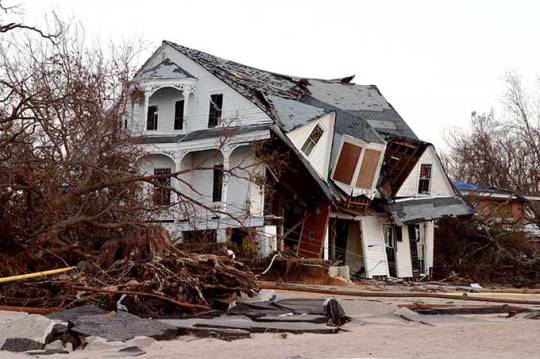
Hurricane Katrina’s high winds and coastal flooding destroyed this beach house in 2005.ParkerDeen/iStock/Getty Images Plus
A storm’s destructive power stems from its winds. Powerful gusts not only blow objects around, they also churn up massive waves called storm surges. This is a rapid rise water that rushes onshore, sweeping away trees, cars and almost anything else in its path. Storm surges can flood buildings, trapping people inside or forcing them onto roofs, where they wait for rescue.
What if there were a way to slow those storm surges, to prevent them from scouring the coastline with their raw power? Turns out, there is — if we allow nature to do its thing.
Coastal wetlands hold the key to damping big waves. They provide flood control and critical habitat for young fish and other marine creatures. They help stabilize climate by trapping carbon. And they’re critical for coasts dealing with rising sea levels.
Standing up to storms
Wetlands are more than just wet land. They are ecosystems of plants and animals thriving in areas that flood at least part of the year. Coastal wetlands are often grassy marshes. Warmer areas may support mangroves. These trees grow right along the coastline, their long, stilt-like roots stretching down into the water. Those roots provide critical habitat for fish, shrimp and other marine animals. They also trap silt and other sediment, protecting it from erosion and building up the shoreline.
Anna Armitage is a marine biologist at Texas A&M University at Galveston. There, she studies coastlines along the Gulf of Mexico. Hurricanes regularly hit this area. She and her team have created study plots with randomly placed patches of marsh and mangrove. As temperatures have been warming, mangroves have been spreading. The team wanted to learn about the ecological changes that take place when mangroves overtake a marsh. But in 2017, their plots took a direct hit from Hurricane Harvey. A category 4 storm at the time, Harvey’s winds raged up to 217 kilometers (135 miles) per hour. The event offered a unique opportunity to study how different types of wetlands survive a big storm.
Explainer: Winds and where they come from
Marshy wetlands came through quite well, researchers found. The storm surge covered the grasses completely. This protected them from damaging winds. “There was erosion right along the shoreline,” Armitage says. But just 10 meters (33 feet) in, the marsh plants were fine. If they were submerged for longer, the plants might have drowned, Armitage notes. But Harvey’s storm surge didn’t last long enough to kill those plants.
High water also protected the shorter, scrubbier mangroves. But trees more than 2.5 meters (8.2 feet) tall, which grew right along the water’s edge, weren’t completely submerged. High winds broke branches above the water and stripped off their leaves. Those areas began to regrow within two months of the hurricane. But they still haven’t completely regrown. “It appears that full mangrove recovery will take longer than two growing seasons,” Armitage says.
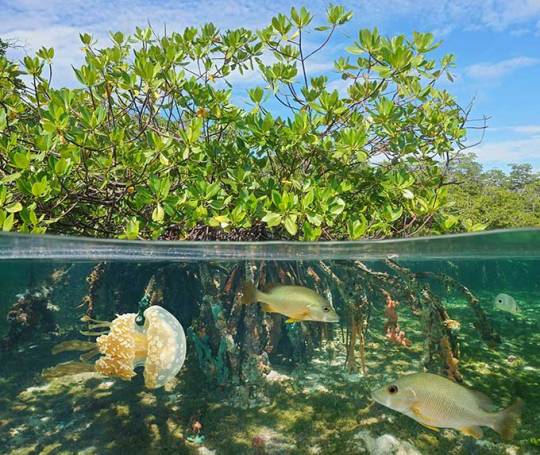
Mangrove roots form a thicket along the waterline, which supports a wide variety of marine life. During storms they can also diminish an oncoming surge of high waves.Damocean/iStock/Getty Images Plus
Both marshes and mangroves help reduce inland flooding. “Mangroves may reduce [storm] surge more because they are taller,” Armitage says. “But their height also makes them more vulnerable to storm damage.” The benefits are about equal between the two types of wetland, she concludes.
Coastal wetlands are essential for flood protection during big storms, says Siddharth Narayan. He’s a coastal engineer at East Carolina University in Greenville, N.C. He and a team of researchers from around the world used a computer model to understand just how much of a difference marshy wetlands make. (A computer program, such a model uses math to predict how a complex real-world event might unfold.)
Explainer: What is a computer model?
They ran their program using Hurricane Sandy as their model storm. This superstorm hit the Northeastern United States in 2012. It killed 72 people and its flooding alone caused $50 billion in damage.
The computer model looked at property damage that Sandy caused along the Atlantic coast from Maine to North Carolina. The team ran the model twice: first with wetlands as they exist now, and a second time with all these wetlands removed. Without those wetlands, the U.S. East Coast “would have experienced $625 million more in damages,” Narayan now reports. Areas upstream from coastal wetlands also benefited in the model — even if they no longer had nearby wetlands. That’s because coastal wetlands would sop up the excess water, slowing the surge upstream.
Wetlands could actually cause a few areas to flood more, according to the model. That’s because homes here had been built between the wetlands and ocean. Those homes wouldn’t get any benefit from wetlands soaking up the storm surge. What’s more, the wetlands would prevent some of that water from moving inland, so flood levels around those homes would rise higher.
Wetlands under threat
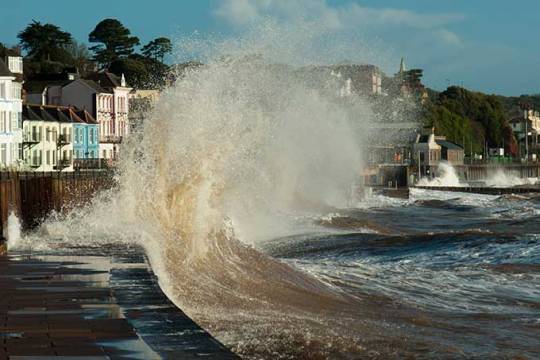
Storms bring extremely high tides and large surges of water that can overwhelm seawalls. Wetlands can sop up some of that bonus water to limit flooding — and in some cases even prevent it. Moorefam/iStock/Getty Images Plus
Narayan’s model didn’t include wetlands as they existed 100 years ago. Those were much larger than today’s. Coastal wetlands have been shrinking around the world for the last century. Anything that interrupts the way they interact with their surroundings can pose risks to them, Narayan says. That can include changes in the flow, temperature or saltiness of water, he notes. That last one is a major problem. If too much freshwater — or salty seawater — gets into the wetlands, it can kill off plants that need just the right amount of salt to thrive.
Wetland sediment also erodes from the constant wash of waves. In the past, spring floods replaced that missing sediment, Narayan says. Swollen rivers carried sediment downstream, depositing it along the way. This rebuilt the sandy base for wetlands along rivers. It also built the broad deltas that form where rivers meet the sea.
But people have altered rivers to prevent floods. Dams hold back sediment, trapping it higher up the river. Riverbanks are often reinforced with concrete, to prevent them from eroding. These changes have stopped the essential flow of nutrient-rich sediment to the river’s deltas and the wetlands they support.
Other threats to wetlands are more direct. People fill them in to build homes, restaurants or hotels. They use chemicals that kill weeds and pests. These can then wash downstream, harming plants and animals along the way. Building roads can cut off the flow of water. Severe storms can kill wetland plants by carving channels that let seawater move too far inland. Other times, Narayan points out, storm surges can be surprisingly helpful, depositing sediment that helps wetlands extend out into the ocean.
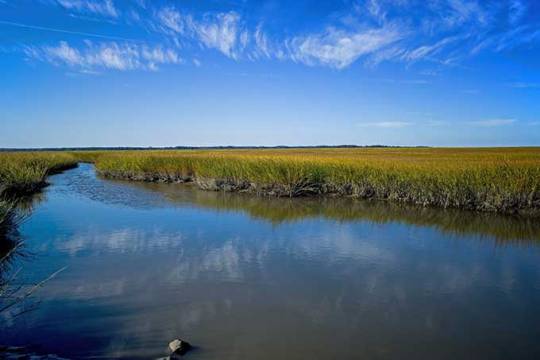
This salt marsh along the Delaware coast allows movement of both fresh- and saltwater through the grasses.McKinneMike/iStock/Getty Images Plus
To survive, coastal wetlands need space to shift, Narayan explains. Wetland plants need specific amounts of salt in the water — too much or too little will kill them. That creates another problem: As Earth’s climate changes, sea levels are rising, pushing saltwater farther inland.
Wetland plants respond to rising sea levels “by growing vertically and also by shifting landward,” Narayan says. They try to “stay in the same tidal range that they’re used to.” But this requires space, he notes. And in many places, human-built barriers prevent a wetland’s ability to move. “As a result, these living wetlands end up getting squeezed against a hard shoreline and drowned,” he says, as the seas rise.
Explainer: Why sea levels aren’t rising at the same rate globally
Exactly how sea-level rise will affect coastal wetlands has been a bit of a mystery. But a recent study by Australian researchers offers hope. Kerrylee Rogers is a coastal scientist at the University of Wollongong. It’s in New South Wales, Australia. Rising seas can play a role in fighting climate change, her team finds. They do this, Rogers explains, by forcing coastal wetlands to store carbon below ground and within the living plants.
The team compared the carbon stored in the sediments of 345 coastal wetlands. They were on every continent except Antarctica. Some were where sea level is rising rapidly. In others, water levels had been largely stable. Where seas had been rising, they found, coastal wetlands collected more sediments and carbon. “As long as the plants can survive, the sediment will continue to store carbon as seas rise,” Rogers concludes. “This will help coastal wetlands to adjust to sea-level rise.” It also could help slow climate change, she notes, by storing more carbon where it can’t be released into the air.
Bringing wetlands back

After Hurricane Sandy in 2012, water flooded — and badly damaged — the Prime Hook National Wildlife Refuge beach road in Delaware, seen here.USFWS/Flickr
People around the world are starting to recognize the important role of coastal wetlands in flood control. And in supporting the fisheries that feed us. Many organizations are now working to restore coastal wetlands. However, those efforts face challenges. Some new wetlands haven’t worked as well as the wetlands they replaced. But with every setback, researchers learn what doesn’t work — and what does. This helps guide their next efforts.
Allowing the flow of water through coastal areas to return to normal seems key. That’s the lesson from Prime Hook National Wildlife Refuge. Home to sand dunes and marsh, it sits along the coast of Delaware. From 2006 to 2012, a series of storms broke through the dune barriers. Saltwater washed into an area that had been freshwater only, killing 4,000 acres of vegetation — an area equal to more than 3,000 football fields. In 2012, Hurricane Sandy blasted through the remaining dunes, completely flooding what had once been a thriving ecosystem.
youtube
See how restoration of Prime Hook National Wildlife Refuge in Delaware revitalized devastated wetlands, helped limit flooding and invited wildlife back.
The next year, the U.S. Fish and Wildlife Service began studying how to best rebuild the refuge. After studying computer models of natural water flow — both saltwater and fresh — they begin a massive restoration project. Bartholomew Wilson led the effort at this government agency.
His team dredged sand from Delaware Bay, using it to rebuild two miles of beach. They dug channels through the former wetland to let both freshwater and salty tides flow through it as they had in the past. Mud from the channels built soil up so that it was higher than the water line. On those mud flats, a team of 12 people planted more than a half million marsh plants to help anchor the sediment in place. A plane dropped about 4,500 kilograms (10,000 pounds) of seeds to further boost plant growth. And a new road along the shoreline now includes a bridge and four pipes that let tidal waters flow freely into the wetland on the other side.

Dredges at Prime Hook in Delaware brought up mud from beneath the floodwaters, spraying it onto nearby areas. This created channels for water flow.Richard Weiner/USFWS/Flickr
It was a massive project — and that was the biggest challenge, Wilson says. “We had a beach being rebuilt with one very large dredge and six bulldozers.” Those moved enough sand to fill 424 Olympic swimming pools. At the same time, three smaller dredges dug 25 miles of channels through the wetlands. “This is the largest restoration project ever on the East Coast,” Wilson says. It’s also one of the most successful, he adds.
By 2018, Prime Hook was a thriving ecosystem again. Many plant and animal species again call it home. These include bird species such as piping plovers, least terns and American oystercatchers. All three species are endangered, and the restored wetland provides habitat that may help boost their populations.
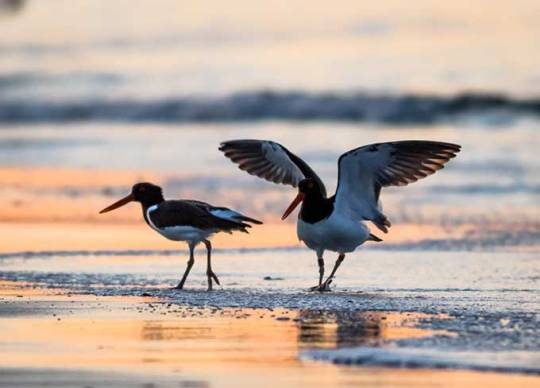
Endangered American oystercatchers rely on coastal wetlands for food and nest sites.Rabbitti/iStock/Getty Images Plus
What’s more, the area has held up well to storms. “We had four storms last year in a few-week period,” Wilson told Science News for Students. And Prime Hook experienced “only minor erosion,” he says. No hurricanes like Sandy have yet tested the area’s resiliency. But one nor’easter brought a near-record storm surge — and it had very little impact on the restored refuge. (Nor’easters are a type of big, intense storm that can strike the northeastern United States.)
Wetland restoration benefits human communities, too. “Before the project, several of the roads leading through the refuge would flood every month or two,” Wilson says. The project finished in 2016. Since then, these roads haven’t flooded once.
Prime Hook is just one example of a restored coastal wetland. Many others are also underway around the world. Organizations and government agencies often work together, says Narayan of East Carolina University. They might move a road to give nearby wetlands more space. Or they might nourish them with sand or mud that, for a while, had been prevented from reaching the area. Adding culverts (openings) under roads can allow tidal flow in and out of a wetland that’s been disconnected from the ocean. It’s a big task, but many teams are up to tackling it.
“People are trying to figure out how we can work with nature to improve the health of these wetlands,” Narayan says. There is no one right answer on how to do this. And the solutions will vary with the site. But in the end, he says, such efforts can pay big benefits to both the environment and human communities.
Soggy coastal soils? Here’s why ecologists love them published first on https://triviaqaweb.tumblr.com/
0 notes
Text
Mangrove plants flourish on coastlines, but rising seas may eradicate them by 2050
Mangrove trees and shrubs grow along tropical and subtropical coastlines, thriving in conditions that would kill most other plants. Mangroves also absorb a lot of excess carbon dioxide from the atmosphere (Kerrylee Rogers /)
If we don’t curb fossil fuel emissions, mangroves around the world will be drowned by rapidly rising seas, researchers reported June 4 in the journal Science. The scientists used sediment cores to examine how the ancestors of today’s mangroves responded to sea level rise thousands of years ago. They found that when the seas rose more quickly than 6.1 millimeters per year, mangroves were typically unable to survive. The team concluded that there’s only a 6.2 percent chance that mangroves will be able to keep growing without being overtaken by the encroaching water by 2050.
“Rates of sea level rise in many tropical coastlines are going to exceed 7 millimeters per year in [2050], so there’s a very low probability that they’ll be able to sustain growth,” says Erica Ashe, a climate data scientist at Rutgers University-New Brunswick and a coauthor of the new study.
Mangrove trees and shrubs grow along tropical and subtropical coastlines across the Americas, Asia, Africa, and Australasia. They thrive in conditions that would kill most other plants, with salty water flooding over their roots whenever the tide comes in. These roots shelter vulnerable young fish and crustaceans, many of which are eventually caught by fishers. Mangroves also absorb a lot of excess carbon dioxide from the atmosphere; per acre, Ashe says, they store more carbon than rainforests do. Additionally, they protect the coastline from strong waves and storm surge and trap sediments within their ever-growing root systems, processes that prevent erosion and increase the elevation of the soil.
As tough as mangroves are, they are in a precarious position. With greenhouse gas emissions fueling climate change, seas around the world are swelling as warm water expands and land ice melts. “Under low to moderate rates of sea level rise they are able to ‘keep pace’ with sea level rise, literally by building up the land surface,” Neil Saintilan, an ecologist at Macquarie University in Australia and a coauthor on the study, said in an email.
Saintilan, Ashe, and their colleagues wanted to determine the threshold at which mangroves become unable to cope with rapidly rising seas. They examined published data from sediment cores extracted from 78 tropical and subtropical locations. These cores contained evidence of bygone mangroves: bits of preserved pollen and roots and distinctively dark, carbon-rich sediments trapped by those roots.
The researchers used this record to figure out when and where mangroves were growing from roughly 10,000 to 7,000 years ago. During this time, melting of the Laurentide ice sheet, which once covered much of Canada and the northern United States, caused sea levels to rise rapidly in many places before slowing down and eventually stabilizing. Computer modeling allowed the team to estimate how quickly sea levels changed over time at the sites where the cores had been collected. “Generally, as sea level [rise] decelerated we would see these mangroves take hold,” Ashe says.
She and her team found that, on average, when the seas rise more quickly than 6.1 millimeters per year, there’s a roughly 90 percent chance that mangroves will be unable to keep growing. Once this rate surpasses 7.6 millimeters per year, there’s a 95 percent chance that mangroves will be outpaced by the rising water.
The world’s seas are currently rising at an average pace of 3.4 millimeters per year. But if we do not sharply cut fossil fuel emissions, the rate of sea level rise is predicted to exceed 5 millimeters per year by 2030 and 7 millimeters per year by 2050 in many tropical areas.
However, all is not lost—we still have a chance to save mangroves from a watery grave. By protecting shoreline habitats from development, we can leave mangroves room to retreat inland. And by significantly cutting greenhouse gas emissions, Ashe says, we can keep the rate of sea level rise below the threshold where it will overtake mangroves in many areas.
“We have demonstrated that mangroves can largely survive the rates of sea-level rise projected under the low emissions scenarios that we expect to occur if greenhouse gas emissions are controlled (under the Paris Agreement, for example),” Saintilan said. “The future of the world’s mangroves is in our hands.”
0 notes
Text
Mangrove plants flourish on coastlines, but rising seas may eradicate them by 2050
Mangrove trees and shrubs grow along tropical and subtropical coastlines, thriving in conditions that would kill most other plants. Mangroves also absorb a lot of excess carbon dioxide from the atmosphere (Kerrylee Rogers /)
If we don’t curb fossil fuel emissions, mangroves around the world will be drowned by rapidly rising seas, researchers reported June 4 in the journal Science. The scientists used sediment cores to examine how the ancestors of today’s mangroves responded to sea level rise thousands of years ago. They found that when the seas rose more quickly than 6.1 millimeters per year, mangroves were typically unable to survive. The team concluded that there’s only a 6.2 percent chance that mangroves will be able to keep growing without being overtaken by the encroaching water by 2050.
“Rates of sea level rise in many tropical coastlines are going to exceed 7 millimeters per year in [2050], so there’s a very low probability that they’ll be able to sustain growth,” says Erica Ashe, a climate data scientist at Rutgers University-New Brunswick and a coauthor of the new study.
Mangrove trees and shrubs grow along tropical and subtropical coastlines across the Americas, Asia, Africa, and Australasia. They thrive in conditions that would kill most other plants, with salty water flooding over their roots whenever the tide comes in. These roots shelter vulnerable young fish and crustaceans, many of which are eventually caught by fishers. Mangroves also absorb a lot of excess carbon dioxide from the atmosphere; per acre, Ashe says, they store more carbon than rainforests do. Additionally, they protect the coastline from strong waves and storm surge and trap sediments within their ever-growing root systems, processes that prevent erosion and increase the elevation of the soil.
As tough as mangroves are, they are in a precarious position. With greenhouse gas emissions fueling climate change, seas around the world are swelling as warm water expands and land ice melts. “Under low to moderate rates of sea level rise they are able to ‘keep pace’ with sea level rise, literally by building up the land surface,” Neil Saintilan, an ecologist at Macquarie University in Australia and a coauthor on the study, said in an email.
Saintilan, Ashe, and their colleagues wanted to determine the threshold at which mangroves become unable to cope with rapidly rising seas. They examined published data from sediment cores extracted from 78 tropical and subtropical locations. These cores contained evidence of bygone mangroves: bits of preserved pollen and roots and distinctively dark, carbon-rich sediments trapped by those roots.
The researchers used this record to figure out when and where mangroves were growing from roughly 10,000 to 7,000 years ago. During this time, melting of the Laurentide ice sheet, which once covered much of Canada and the northern United States, caused sea levels to rise rapidly in many places before slowing down and eventually stabilizing. Computer modeling allowed the team to estimate how quickly sea levels changed over time at the sites where the cores had been collected. “Generally, as sea level [rise] decelerated we would see these mangroves take hold,” Ashe says.
She and her team found that, on average, when the seas rise more quickly than 6.1 millimeters per year, there’s a roughly 90 percent chance that mangroves will be unable to keep growing. Once this rate surpasses 7.6 millimeters per year, there’s a 95 percent chance that mangroves will be outpaced by the rising water.
The world’s seas are currently rising at an average pace of 3.4 millimeters per year. But if we do not sharply cut fossil fuel emissions, the rate of sea level rise is predicted to exceed 5 millimeters per year by 2030 and 7 millimeters per year by 2050 in many tropical areas.
However, all is not lost—we still have a chance to save mangroves from a watery grave. By protecting shoreline habitats from development, we can leave mangroves room to retreat inland. And by significantly cutting greenhouse gas emissions, Ashe says, we can keep the rate of sea level rise below the threshold where it will overtake mangroves in many areas.
“We have demonstrated that mangroves can largely survive the rates of sea-level rise projected under the low emissions scenarios that we expect to occur if greenhouse gas emissions are controlled (under the Paris Agreement, for example),” Saintilan said. “The future of the world’s mangroves is in our hands.”
0 notes
Photo

#TheLight @ammoye album release and showcase! Can't wait!!! See you there #reggae Massive! #1love❤️💚💛👆👆🙌🙌 #lightworker #ammoye #Toronto #Canada #Worldwide #ForwardUp #BlessUp! #RootsReggaeHub recommended events! #SoulRebelz June29th!!! Come celebrate the release with Ammoye inside @modclubtheatre with special guests @excolevi @blessedb3 & @michiebadgyalmee!!! Also featuring #Dj's @deejayshai & @chocolatelauren!!! #Hosted by @g987fm @steps_after_dark #KerryLee!!! #LiveBand @dicruband!!! Get your tickets at www.EventBrite.ca #Factor #CAC #TAC @evolutionpr_ @l3magazine #Rebelz!!!! #Lightworker #Andsoitis ✨✨✨✨💕🦋 #musicismylife #ShowTime 9pm!!! (at Mod Club Theatre)
#rootsreggaehub#hosted#lightworker#tac#blessup#kerrylee#soulrebelz#worldwide#thelight#rebelz#1love❤️💚💛👆👆🙌🙌#reggae#andsoitis#showtime#musicismylife#forwardup#dj#ammoye#toronto#cac#liveband#canada#factor
0 notes
Photo

#TheLight @ammoye album release and showcase! Can't wait!!! See you there #reggae Massive! #1love❤️💚💛👆👆🙌🙌 #lightworker #ammoye #Toronto #Canada #Worldwide #ForwardUp #BlessUp! #RootsReggaeHub recommended events! #SoulRebelz June29th!!! Come celebrate the release with Ammoye inside @modclubtheatre with special guests @excolevi @blessedb3 & @michiebadgyalmee!!! Also featuring #Dj's @deejayshai & @chocolatelauren!!! #Hosted by @g987fm @steps_after_dark #KerryLee!!! #LiveBand @dicruband!!! Get your tickets at www.EventBrite.ca #Factor #CAC #TAC @evolutionpr_ @l3magazine #Rebelz!!!! #Lightworker #Andsoitis ✨✨✨✨💕🦋 #musicismylife #ShowTime 9pm!!! (at Mod Club Theatre)
#canada#tac#rebelz#toronto#ammoye#dj#liveband#showtime#thelight#musicismylife#soulrebelz#forwardup#worldwide#1love❤️💚💛👆👆🙌🙌#reggae#rootsreggaehub#kerrylee#andsoitis#cac#hosted#blessup#lightworker#factor
0 notes